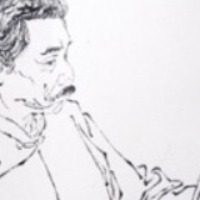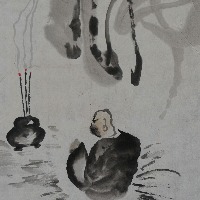Marjorie Perloff
Abstract:This essay,following upon Kyoo Lee’s case for “counterreading”,argues for what I call “micropoetics”:a close reading that takes into account every phoneme,morpheme,and word of a poetic text and reads that text “verbivocovisually”,to use James Joyce’s term.I take as my model Marcel Duchamp’s concept of the infrathin — the smallest possible distinction,whether temporal or spatial,between A and B.Similarity and analogy,I argue,have been overstressed and produced the problematic political discourse of the present with its clichés and vapid generalizations.Infrathin reading,on the other hand,establishes difference and the uniqueness of a given text,as I show in the case of Gertrude Stein’s “Miss Furr and Miss Skeene”,where the seeming repetition of phrasing is actually a form of elaborate word play.
Keywords:micropoetics;Infrathin;repetition;difference;Duchamp;Stein;de Campos;Baudelaire;counterreading;cliché
Mere reading,it turns out,prior to any theory,is able to transform critical discourse in a manner that would appear deeply subversive to those who think of the teaching of literature as a substitute for the teaching of theology,ethics,psychology,or intellectual history.(de Man 24)
Citing this statement by Paul de Man,Kyoo Lee remarks,“Such a close reading,not exactly closed,did and does open up a new vista of textual space while spacing itself in the form of a chronotopological intervention as well as invention.”And then,in her uniquely good-humored way,Lee steps back a bit and remarks,“My scope,narrower and smaller,however,is almost micro-philopoetic,kind of zen-focused”.I want here to ruminate further on the “micro-philopoetic” reading practice,which is increasingly my own.No doubt “close listening”,as Charles Bernstein called it in hisClose
Listening:Poetry
and
the
Performed
Word,is necessary in an age where most reading is merelyrotereading,in response to the daily Fake News.We have come a long way from Jean-Fran?ois Lyotard’s suspicion of “master narratives”,from the late twentieth-century belief that there are no external,definitive truths that govern our lives and that we must learn to accept the complexity that goes with the inherent indeterminacy and oscillation of language.In 2019,master narratives are once again the order of the day:theNew
York
Timeswill print the sentence,“Donald Trump is a liar”,with the same authority as if the sentence were “Donald Trump is 6’1” tall”.One isn’t,in current parlance,accused of telling a lie;oneisexistentially a liar.Or again,not “X made a racist remark”,but “Xisa racist”.Who would have believed,that in the wake of Derrida’s seminal demonstration ofdifferance,we would,in our new century,traffic once more in constant declarations about whatis.Then,too,in our digital age,the act of reading/writing is qualified by its alternatives.Here I plead guilty.It has,for example,become my habit,in recent years,to hear novels or non-fiction books rather than to read them.It is very relaxing,late at night,to listen to Henry James’sThe
Golden
Bowl,read by Juliet Stevenson,downloaded from the wonderful site Audible.com.Listening,rather than reading the novel,I have noticed that James’s sentence structure uncannily prefigures Gertrude Stein’s repetitions,as in “He knew that she knew that he was knowing[...].” Stein often expressed her enormous admiration for James,but critics have mostly paid attention to her relationship to Henry’s brother William,her teacher at Harvard.Or again,when I listen to Jeremy Northam read George Orwell’sHomageto Catalonia,Orwell’s theme — the futility of war and the terrible fate of the idealistic revolutionaries in the Spanish Civil War — comes across with special force.I listen to these books while stuck in traffic in Los Angeles.More and more,it’s gridlock on our streets,and Audible.com makes driving them bearable.But I find that it only works with books I already know;a difficult new novel or critical text or essay in art theory by,say,T.J.Clark — these are not really amenable to “highway listening” because we are distracted by unexpected traffic incidents:a sudden slow-down,an accident,a red light.
Email and Social Media reading and writing are similarly fraught.When I dictate on my iphone,as I often do early in the morning as I loll in bed,frustration quickly sets in! When I write “I look forward to meeting you”,it’s likely to be transcribed as “I look forward to beating you”,“Ashbery” (John Ashbery)becomes “asshole” and when I wrote to a friend that I had seen a wonderful exhibition of Faulkner manuscripts,“Faulkner” emerged as “fuck her”.When experts tell you that A.I.will soon replace us,don’t believe it;in my experience,such recording systems as GPS and Voice Mail and Siri on one’s iphone,often seem to understand less than would a young child.Siri can’t even spell “too” correctly;invariably it’s merely “to”.So “I am going too” becomes “I am going to”,which leaves the reader in suspension.What a difference a single letter can make! Paradoxically,the current digital situation,has increased my longing for what Kyoo Lee calls “micro-philopoetic” reading.And here my guide is that great artist of the twentieth century,Marcel Duchamp,who gave us those crucial new forms,thereadymade,the “delay” in glass calledThe
Bride
Stripped
Bare
by
her
Bachelors,Even,and especially the concept of theinfrathin(inframince),as described in a set of numberedNotes(43 in all),edited by Paul Matisse:What doesinfrathinmean? Duchamp said the word defied definition,one could only know it by example.For instance,1.The possible is an infrathin.
4.The warmth of a seat (which has just been left)is infrathin.
7.In time,the same object is not the same after a one-second interval.
8.Sliding doors of the Métro.The people who pass through at the last minute/infrathin—12.The infrathin separation between the sound of thedetonationof a gun (very close)andthe apparition of the bullet hole in the target.15.Painting on glass seen from the side that is not painted produces an infrathin.
18.The difference (dimensional)between 2 objects in a series (made from the same mold is an infrathin when the maximum (?)of precision is applied.(Duchamp 21-24)This last “infrathin” is especially important,recalling as it does Ludwig Wittgenstein’s searching question in thePhilosophical
Investigations:“But isn’t the same at leastthe
same(215)? The answer,at least for the poet and the poet’s reader,is always no.The
same,as Gertrude Stein knew so well,is constantly changing,howeverinfrathinthe change that takes place at every iteration:They stayed there and were gay there,not very gay there,just gay there.They were both gay there,they were regularly working there both of them cultivating their voices there,they were both gay there.Georgine Skeene was gay there and she was regular,regular in being gay,regular in not being gay,regular in being a gay one who was one not being gay longer than was needed to be one being quite a gay one.They were both gay then there and both working there then.(Geography
and
Plays17)This passage,from Stein’s famous short story “Miss Furr and Miss Skeene”,repeats the word “gay” twelve times within its 98-word span.“Gay,” in Stein’s day,literally meant “happy”,“jolly”,“good-humored”,but it already had its underground meaning of “homosexual”.“There” appears eleven times and “they” five times in the first three lines and once in the last sentence.But just when the reader thinks “they” (the couple Miss Furr and Miss Skeene)are the same,the word “regular” and its adverbial form (used five times)enters as a qualifier,and we learn that Miss Skeene,as opposed to Miss Furr,is not quite regularly gay after all.She was “a gay one who was one not being gay longer than was needed to be being quite a gay one.” The infrathin is operative:Miss Skeene,in other words,is not quite in sync with her lover,and indeed in the course of this very short story,the two women will split up.Stein’s entire story depends upon the most careful manipulation of the wordsgay,cultivating,working,regular/regularly,there,andthen.Each time “gay” appears it has a slightly different aura,as do those carefully chosen gerundscultivatingandworking.And when exactly wasthen? The more these perfectly ordinary words are repeated,the less we know about the relationship between the two women.Much is left to our imagination,but by the end of the story Helen Furr is alone andtelling(a new verb)everyone else how to begay.But isn’t the same at least the same? No,in fact,everything changes in this tale in which Helen and Georgine,with their related names (fur and skin),meet,fall in love,“live there then” “work”“cultivate their voices” meet men “who are dark and heavy” and later “not so dark and heavy”,and drift apart,Georgine evidently yearning to be elsewhere and with someone else.Like Duchamp,Stein was a master of the infrathin.“Tables”,Duchamp remarked in a later note,“is not the plural of table,ate has nothing in common with eat” (115).To be a reader is to be aware of the difference,however minute,that occurs between such particles depending on thecontext.And here etymology plays a major role.In his 1924 essay “The Meaning of the Word in Verse”,the Russian Formalist Jurij Tynjanov declared “The word does not exist outside of a sentence.An isolated word is not found in a non-phrasal environment” (135).Indeed,“Coloration is owed to the location of the word in a particular verbal context.” (Tynjanov 143).And Tynjanov used the example of the Russian wordzemlja— earth,soil,ground — so as to show how different contexts made for very different meanings:Zemlja and Mars:Earth and Heaven
Bury an object in the zemlja (soil)
It fell on the zemlja (floor)
Native zemlja (native country)(137)“The difference”,as Stein put it inTender
Buttons,“is spreading” (11).And context can be tricky! One of my favorite poet-theorists,the Brazilian Haroldo de Campos,remarks,in an important essay of 1981 on poetic function and the ideogram,“Whereas for the referential use of language,it makes no difference whether the wordastre(star)can be found with the adjectivedésastreux(“disastrous”)or the noundésastre(“disaster”)[...] for the poet this kind of “discovery” is of prime relevance” (294).De Campos takes his example from Mallarmé,but one from Baudelaire’s “Le Voyage” may be even more apposite:Nous avons vu des astres
Et des flots,nous avons vu des sables aussi;
Et,malgré bien des chocs et d’imprévus désastres
Nous nous sommes souvent ennuyés,comme ici[...] (IV,1,124)
In my literal translation:
We have seen stars
And seas,we have seen sands too;
And despite many shocks and unforeseen disasters
We have often been bored,as we are here[...]Here the rhymingastres(stars)anddésastres(disasters)are presented as alternatives.Neither the exotic and beautiful vistas encountered on the poet’s journey nor the terrible dangers encountered can allay the terrible ennui of modern life.But the noundésastrecomes from combining the negative prefixdesordiswithastron(Greek for “star”);the reference,in other words,is to the negative role of the stars—to that which isill-starred.So in fact,astresanddésastres(Baudelaire,IV,1),nouns unrelated in ordinary discourse,do go together.In poetry,as Ernest Fenollosa succinctly put itin
The
Chinese
Written
Character,“relations are more important than the things related” (22).Note that this approach to reading poetry is by no means equivalent to the New Criticism or even to what is usually called Formalism.It is customary today to dismiss the latter as “mere” close reading,the “mere” explication of the words on the page,without considering their political or cultural or anthropological valence.But Duchamp,Stein,and de Campos — all of them themselves artists or poets — knew better.They understood that the poet’s role is not to “say” — any writer of nonfiction can do that — but how tomakea new construct from the language pool.The social media,unfortunately,work against this process.They urge us,at every moment,to skim,to click on the BREAKING NEWS which usually are not “news” at all,and to reducereadingto the intake of information bytes that are digested and then forgotten as quickly as is fast food.All the more reason to sensitize ourselves to theinfrathin,to unmask the daily news cycle by practicing what Kyoo Lee callscounter-reading.Here is Duchamp’s Note #35:2 forms made from the same mold (?)are different from one another by an infrathin separation[…]
 But wait a minute,you will ask,who compares binoculars to drops of water? Politicians and journalists do so all the time.“It’s no silver bullet”,says Senator X,explaining why a certain piece of legislation may not work.Or consider the cliché of “getting down to brass tacks” when there isn’t a brass tack in sight.But mybête
But wait a minute,you will ask,who compares binoculars to drops of water? Politicians and journalists do so all the time.“It’s no silver bullet”,says Senator X,explaining why a certain piece of legislation may not work.Or consider the cliché of “getting down to brass tacks” when there isn’t a brass tack in sight.But mybête
noireis that graphic metaphor applied to those who have done something unforgivable or must be cast aside for political expediency:they are to be “thrown under the bus”.What a set of nothingburgers! Surely it’s time to read differently,to read differentially,to respond to texts,as does Kyoo Lee,with all the infrathin attention we can muster.
Works CitedBaudelaire,Charles.Oeuvres
Completes.Paris:Bibliothèque de La Pleiade,Gallimard,1961.Bernstein,Charles.Close
Listening:Poetry
and
the
Performed
Word.New York:Oxford University Press,1998.De Campos,Haroldo.“Poetic Function and the Ideogram.”Novas:Selected
Writings
of
Haroldo
de
Campos.Eds.A.Sergio Bessa and Odile Cisneros.Evanston:Northwestern University Press,2007.287-311.De Man,Paul.The
Resistance
of
Theory.Minneapolis:University of Minnesota Press,1986.Duchamp,Marcel.Notes.Ed.Paul Matisse.Paris:Flam-marion,1999.Fenollosa,Ernest,The
Chinese
Written
Character
as
a
Medium
for
Poetry.Ed.Ezra Pound.San Francisco:City Lights Books,1968.Lyotard,Jean-Fran?ois.The
Postmodern
Condition:A
Report
on
Knowledge.Trans.Jeff Bennington and Brian Massumi.Minneapolis:University of Minnesota Press,1984.Stein,Gertrude.“Miss Furr and Miss Skeene.”Geography
and
Plays.Ed.Cyrena Pondrom.Madison,WI:University of Wisconsin Press,1999.17-22.- - -.Tender
Buttons.Ed.Seth Perlow.San Francisco:City Lights,2014.Tynjanov,Jurij.“The Meaning of the Word in Verse.”Readings
in
Russian
Poetics:Formalist
and
Structuralist
Views.Eds.Ladislav Matejka and Krystyna Pomorska.Cambridge:MIT Press,1971.136-45.Wittgenstein,Ludwig.Philosophical
Investigations.Eds.P.M.S.Hacker and Joachim Schulte.Trans.G.E.M.Anscombe,P.M.S.Hacker and Joachim Schulte.Oxford:Wiley-Blackwell,2009.

















